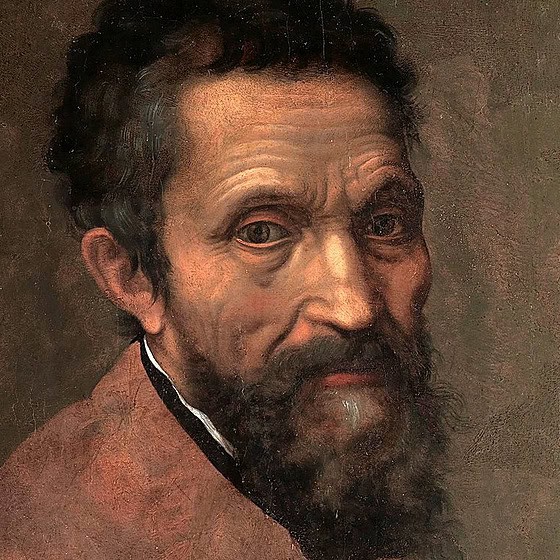"Perfection is achieved by little things, but perfection is not little."
If people knew how much work it took me to master my mastery, they wouldn't consider me a genius."
"The goal of art is to make people happy."
550 years ago, he was born Michelangelo di Lodovico Buonarroti Simoni, one of the most famous representatives of the High Italian Renaissance. Few artists have made their mark on the history of art as significantly as he did. He was a unique sculptor, painter, architect and poet. He considered himself above all a sculptor, and before he was thirty he had already carved two of the most famous sculptures in the history of art out of marble, Pieta a David. As a painter he created the famous fresco decorations of the Sistine Chapel in the Vatican, his frescoes The Last Judgement a Creation of the world are the pinnacle of Renaissance painting. The whole world comes to Italy to see his works.
Michelangelo lived and worked for almost a century and was very industrious throughout his life, still working at the age of 88, six days before his death. He lived in turbulent times, when medieval religion was swept away and the Reformation began. He was an artist who was able to adapt to these times and portray them brilliantly in his works. Among his contemporaries, he was held in unprecedented esteem, called Il Divino - Divine. But because of the nudity of his characters, he also had an unflattering nickname Inventor delle porcherie - literally The inventor of the pranks and was the first artist whose figures were covered with fig leaves. He was also the first to have his life documented by two biographers during his lifetime.
He was born in a stone house in the town of Caprese near Arezzo in Tuscany on Monday 6 March 1475, the second of five sons of Lodovico Buonarroti Simoni and his wife Francesca di Neri di Miniato del Sera. He was born in dramatic circumstances when his parents, despite his mother's advanced pregnancy, set out on horseback for the castle of Caprese because of the plague in Florence. On the arduous journey over the mountains, an accident occurred, Francesca fell from the horse that was pulling her along. That night, little Michelangelo was born.
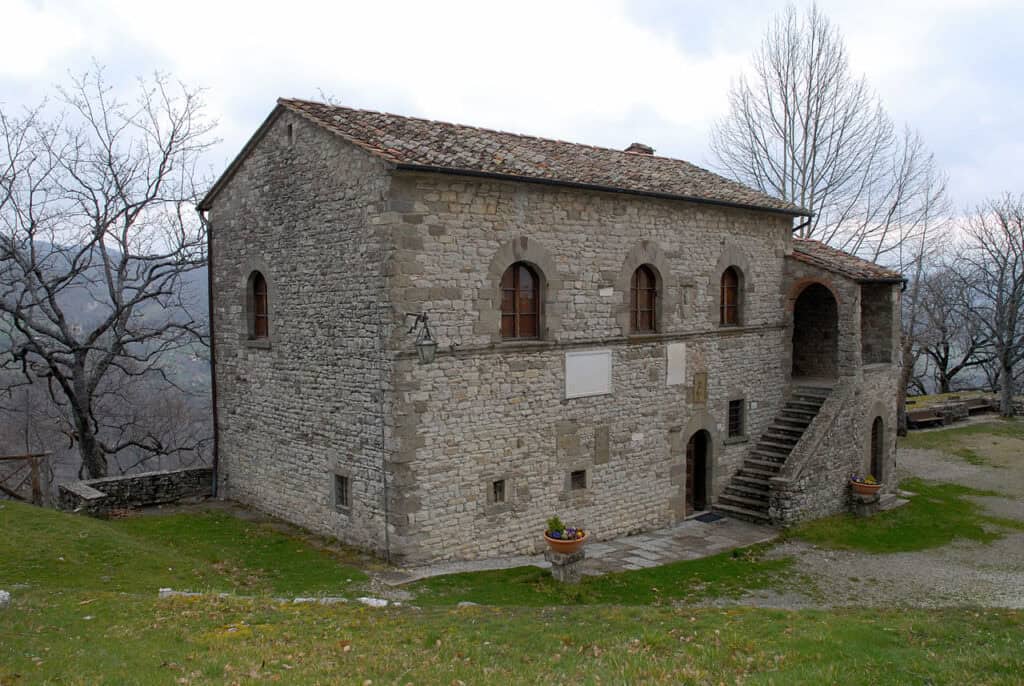
The Buonarroti family belonged to the Florentine patriciate for several generations and none of its members had artistic inclinations, were small bankers and money changers or held public office. The family had its own coat of arms and sponsored a chapel in the Basilica of Santa Croce in Florence. At the time of Michelangelo's birth, however, their bank had failed and his father was serving as a justice of the peace and administrator at the Caprese castle. After six months, the family returned to Florence, but due to his mother's fragile health and his father's financial problems, Michelangelo was placed in the care of a nanny and nurse in the town of Settignano, where the family owned a marble quarry and a small farm. Settignano was a town of stonemasons, and his nanny's husband and father were also stonemasons, so he learned to work with stone as a young boy. Later, as a famous artist, he said he preferred sculpture to painting because he came from a land of sculptors and stonemasons: "If there is something good in me, it is because I was born in the country of Arezzo. Along with my nanny's milk, I drank marble dust and absorbed the art of using the chisel and hammer with which I create my characters."
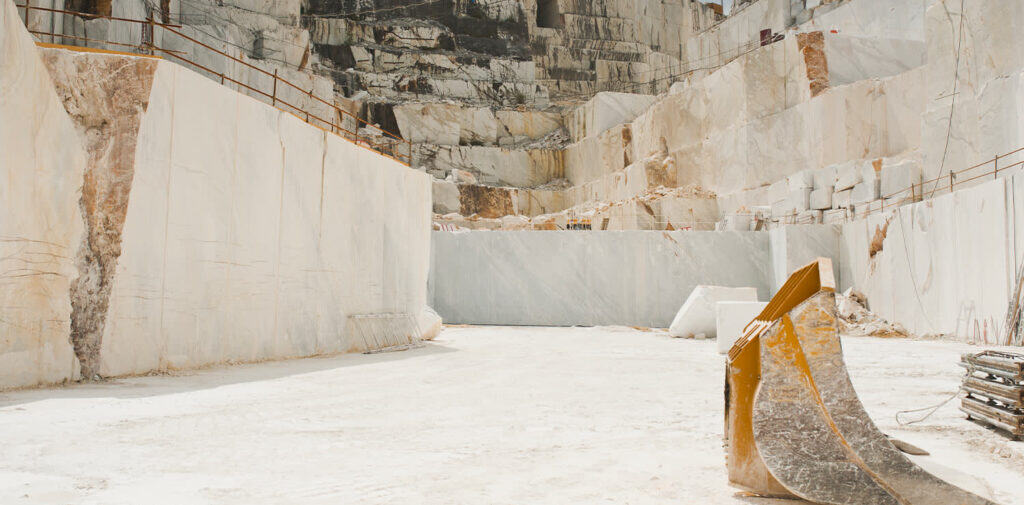
Michelangelo lost his mother at the age of six; she died in 1481 after her fifth childbirth, aged 26. Her father, 11 years older, outlived her by half a century. In 1485, he remarried to Lucrezia Ubaldini (who died in 1497). Ten-year-old Michelangelo, who was bright and gifted from a young age, was sent by his father to study with the humanist Francesco Galatea of Urbino to learn grammar, Latin and mathematics. Michelangelo, however, showed no interest in a humanist education, deliberately did not study well and preferred to seek the company of painters and copy the paintings of the Old Masters in churches. It was then that he met Francesco Granacci, his lifelong friend, who urged him to take up painting.
For Michelangelo's father, however, this was unthinkable; he treated art as manual work unworthy of a son of a patrician family and chose for him a career as a notary. But a family friend, Lorenzo de' Medici, known as il Magnifico - the Magnificent, the uncrowned ruler of Florence and patron of the arts, assured him that a career as an artist was nothing that would harm the family's reputation. So in April 1488, his father agreed to let Michelangelo become an apprentice for three years to Domenico Ghirlandaio, one of the most popular Florentine artists of the time. It was not without interest to the impoverished Lodovico that the master did not ask for tuition and paid advanced apprentices for their work. Later, the father relied directly on his son for financial support.
Michelangelo learned the basics of fresco art in the workshop, which he used twenty years later in Rome. A year later, Ghirlandaio sent two of his best pupils - Granacci and Michelangelo - to the artistic sculpture school in the garden of the Convent of San Marco at the request of Lorenzo the Magnificent. Lorenzo brought the gifted young man to the Medici palace, where important Florentine artists, writers and scholars met, and Michelangelo became almost a member of the family, living in the palace until Lorenzo's death in 1492.
There he became acquainted with the young Medici who later became Popes - Giovanni, Pope Leo X (1475-1521), and Giulio, Pope Clement VII (1478-1534). The famous court and gardens of the Medici were his next artistic school, in which he preferred sculpture to painting. Among his first known sculptural works are reliefs Battle of the Centaurs a Madonna on the stairs, completed in 1492. He received 50 gold florins from Lorenzo for the Madonna.
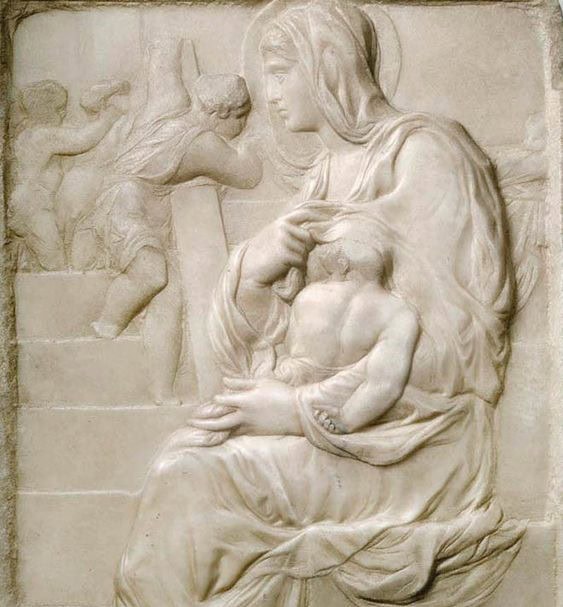
At the time, his classmate was Pietro Torrigiani, two years older, the son of a wealthy Florentine winemaker, who punched him in the nose so hard in an argument that it permanently disfigured him. Torrigiani then fled Florence to escape the wrath of Lorenzo de' Medici. He worked in England, where he created the tombstone of Henry VII and his wife Elizabeth of York, which can still be found in Westminster Abbey, and later was a prominent sculptor in Spain, but it turned out badly. In Seville he was the victim of a scam when a patron paid him a bag of pennies for his work and then, fearing scandal, denounced him to the Inquisition as a secret heretic. Torrigiani was imprisoned and starved to death in his cell. His mastery is still documented today in a life-size terracotta statue of St Jerome in Seville's Museum of Fine Arts.
Michelangelo was left with the memory of the incident in the form of a deformed nose and difficulty breathing for the rest of his life. After the death of Lorenzo the Magnificent, he left the Medici court and returned to his father's house. He carved a wooden crucifix for the Florentine Basilica of the Holy Spirit, and in return the basilica allowed him to study anatomy on dead bodies from the adjacent hospital. He dissected them to understand how muscles work, which is why his sculptures are incredibly realistic.
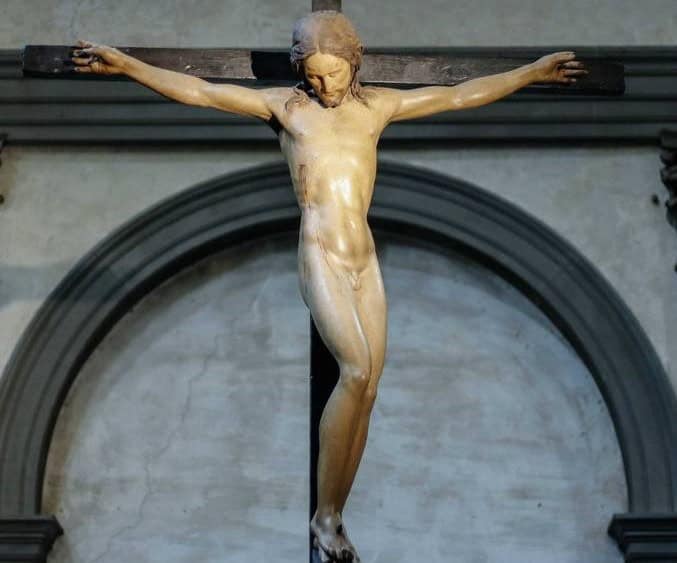
In 1493 he bought a block of marble and carved a statue of Hercules, which was later sent to King Francis I of France (he ascended the throne in 1515), but around 1700 the statue was lost.
At the beginning of 1494 Michelangelo returned to the Medici court, where Lorenzo's son and heir, Peter of Medici, also known as the Unfortunate, commissioned him to build a snow statue. That same year, however, Peter de' Medici had to flee Florence from the troops of the French king Charles VIII, and although he tried to enlist the help of neighbouring kings and princes, he never returned to Florence, drowning in the Garigliano River in 1503.
The fanatical Dominican monk Girolamo Savonarola, who was admired by Michelangelo's uncle Francesco, took over Florence and in 1494-1498 transformed the republic into a strictly theocratic state - the Republic of Christ, from which all Renaissance debauchery and human iniquity was to be eradicated. Unfortunately, as part of this "purification", he also had works of art he considered immoral destroyed. However, he made the mistake of criticizing not only members of the Borgia family in his sermons, but also Pope Alexander VI, who cursed and excommunicated him for heresy in 1497. When Savonarola ignored this and continued to preach, he was arrested, tortured, hanged and finally burned posthumously in 1498. This is somewhat reminiscent of the fate of the Czech Master Jan Hus in 1415, but he was pointing out the corruption of the Church, not criticizing the whole of society. The Medici did not return to Florence until 1512.
Under the influence of the turbulent events, Michelangelo left Florence, first for Venice and then for Bologna. In Bologna he received a commission for a small altar of St Dominic for the church of the same name, but needed more commissions to help his father out of debt. The story goes that he helped himself with a little trickery; in 1496 he created a life-size statue of a sleeping Cupid, had it stretched in acid clay and sold it as an antique from the time of ancient Rome to Cardinal Raffaele Riar of San Giorgio by the art dealer Baldassare del Milanese. The forgery was plausible, but the cardinal discovered it after a time, returned the statue and demanded his money back from Baldassare. The cunning merchant promptly sold it again, and in the 16th century it appeared in the collection of the d'Este family in Mantua alongside the original ancient statue, eventually ending up in the British palace at Whitehall, where it fell victim to a fire.
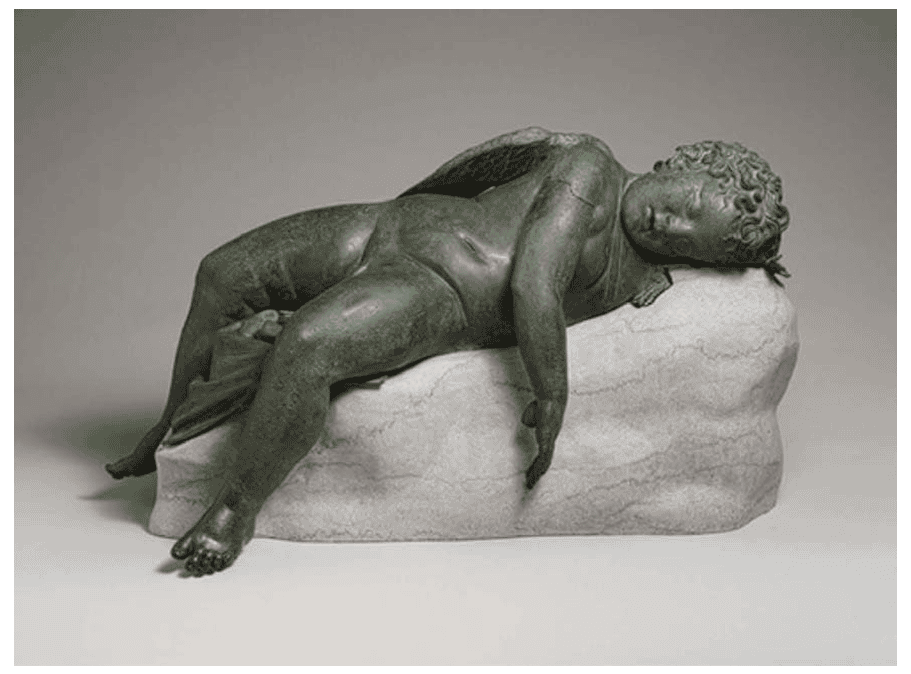
Michelangelo was invited to Rome instead of being punished, and the cardinal was impressed by his art. He lived in Rome for five years from 1496, and fortune favored him - he was not yet twenty-five when he produced one of his most famous works - Pieta. This sculpture brought the young artist fame and new commissions. He depicted the Madonna based on the memory of his mother, and to criticism that she looked too young compared to Jesus, he replied that people with pure souls do not age. It is the only work he signed, for after its installation in St. Peter's Basilica in 1900 there was doubt that such a young and relatively unknown sculptor could have created something so remarkable. He therefore carved the inscription on the sash across Mary's chest Michelangelus Buonarrotus Florent Faciebant (Created by Michelangelo Buonarroti from Florence). He received 450 gold papal ducats for his work.
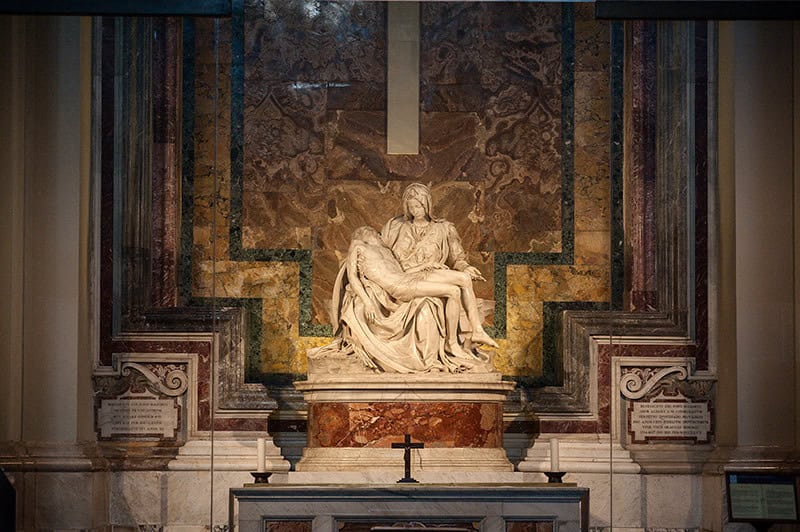
After Florence was declared a republic in 1501, Michelangelo returned home from Rome and three years later completed the statue of David commissioned by the Florentine Signoria, the first nude to be exhibited in a public place since antiquity, at the entrance to the Palazzo Vecchio, Florence's town hall in the Piazza della Signoria. 370 years later, the original statue was placed in the local Accademia gallery and a marble copy was installed in its original place, which used to be covered with a large fig leaf to prevent the naked David from offending the ladies. In the statue of David, Michelangelo was able to combine the ancient ideal of harmony and physical beauty with Renaissance concepts, exactly in line with the aesthetic principles of the time.
He was obsessed with the perfection of his works, he carefully chose the marble blocks for his sculptures and often even broke them himself in the quarries in Carrara, so much was it important to him how the uncut stone looked.
However, it was different for the statue depicting the biblical David just before the duel with Goliath. For it, he worked on a block of Carrara marble, five metres high, with a base of one metre by one metre, with many blemishes and deposits, weighing approximately six tonnes, which had stood abandoned for almost 40 years in front of Florence's Santa Maria del Fiore Cathedral. Two sculptors tried to make a statue of it, but gave up. Only Michelangelo succeeded after three years of hard work. When he began, he had an almost mystical belief that the figure already existed inside the stone block and he just had to free the biblical hero from his stone prison.
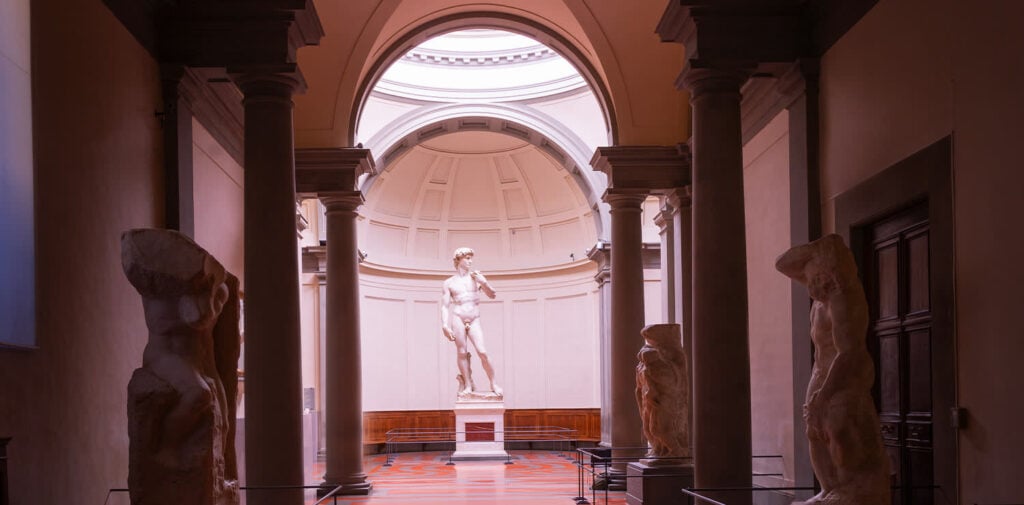
"Each stone block has a statue inside, and the sculptor's task is to discover it," He said. But it happened that he was dissatisfied with himself in this respect - later, when he was working on a statue of Moses that was not going well, he struck a stone with a mallet, saying: "Why aren't you talking to me?"
The statue of David made its creator famous and ensured his immortality. For his work, he is said to have received 900 gold ducats, more than Leonardo da Vinci earned in his lifetime.
In early 1505, Pope Julius II summoned Michelangelo to Rome. He officially hired him for five years to build a monumental tomb for him. Michelangelo drew up a design for a 6.9×10.8×7.2 metre tomb containing forty life-size statues, and immediately went to Carrara for several months to personally procure blocks of marble.
During his absence, a group of artists from the papal circle, led by Donato Bramante, jealous of Michelangelo's popularity, discouraged the Pope from building the tomb, and forced him to finance the rebuilding of the papal Constantine Basilica into the larger and more modern St Peter's Basilica instead. The Pope therefore postponed work on the tomb, saying that he first had to build a worthy residence for it, and in 1506 he used the funds to build the basilica, which he had just commissioned Bramante to build, and for new war plans against Perugia and Bologna. Michelangelo asked in vain for a hearing to be held for reimbursement of expenses and to keep the contract. Eventually he was forcibly ejected from the palace by the soldiers and fled in indignation from Rome to Florence.
The Pope, however, soon demanded his return. Michelangelo complied only at the insistence of the gonfalonier Piero Soderini, who ruled Florence after Savoranello and feared conflict with the papal state. Michelangelo met the Pope in Bologna in November 1506 and was commissioned to create a larger-than-life bronze statue of Julius II, which was installed in the conquered city. Unfortunately, it was destroyed two years after its creation, immediately after the Pope's opponents reconquered the city.
Between 1508 and 1512, Michelangelo was back in Rome, where the Pope gave him the daunting task of decorating with frescoes the huge ceiling of the Sistine Chapel in the Apostolic Palace, famous the world over for the conclaves - the gatherings of the College of Cardinals that elect the Pope.
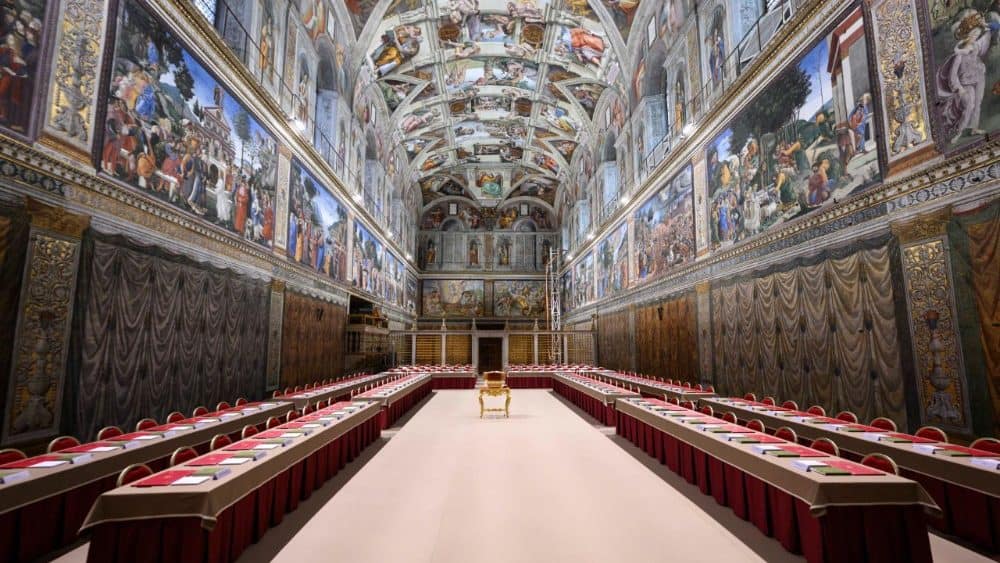
Michelangelo, although he felt he was primarily a sculptor, accepted the commission. He found painting frescoes from high scaffolding difficult, using an ancient method that relies on a chemical reaction between wet lime plaster and water-based pigments to permanently bond the work to the wall. He was given free rein by the Pope to choose his own motifs for the rugged ceiling. He chose nine episodes from the book of Genesis. He worked day and night, lighting his work with candles attached to his hat. On the arches of the 20-meter-high ceiling, he depicted biblical scenes from the creation of heaven and earth, the creation of Adam, the creation of Eve from Adam's rib, the original sin of Adam and Eve, Noah's sacrifice, the flood, Noah's ark, and death, for a total of more than three hundred figures. In order to make the frescoes clear and clearly visible from every point, he had to create figures of superhuman proportions, whose proportions are on the verge of distortion.
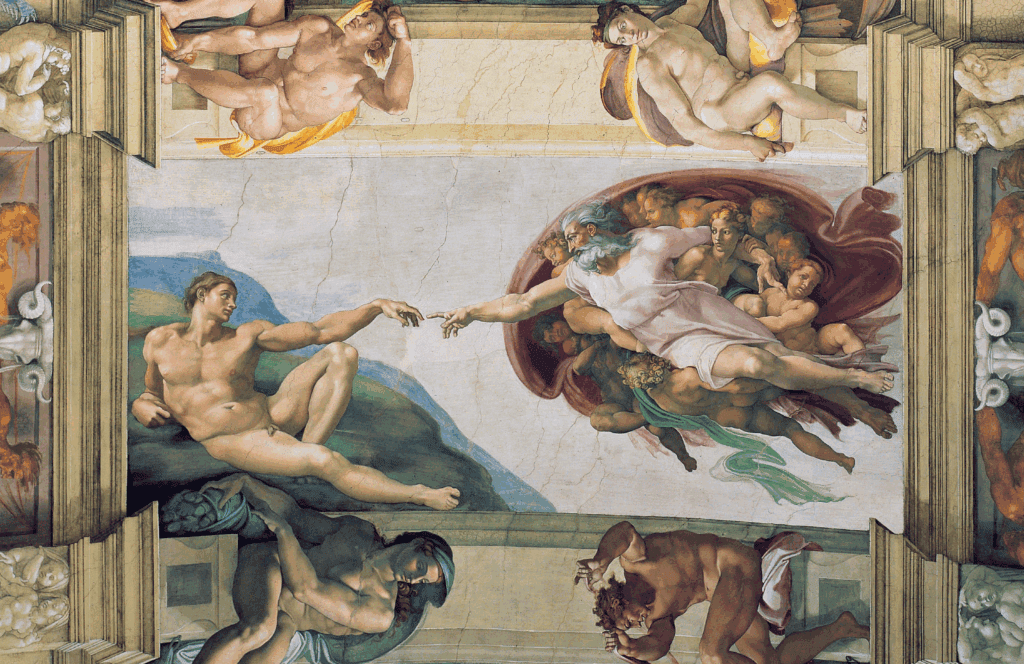
Throughout the work, he faced technical problems. When he finished The Flood, one of the main scenes in the central part of the ceiling, the painting became covered with a white coating and disappeared. It turned out that he had put too much water in the plaster that was the base for the paint, and the peculiar properties of the Roman lime caused mould to appear. He had to remove it and repaint the picture. For four years he lay on his back on scaffolding, paint dripping into his eyes, fighting the Pope and himself. He described the difficult work in his sonnet:
Beard to the sky, back of the head,
on the very hump, the breast of the bird creature,
and how the brush keeps spraying from above,
He's already paved my face generously.
...
Therefore, defend yourself, my dear,
my silent work and my reputation with it:
I'm not a painter and I don't belong here...
The finished fresco was unveiled on the eve of All Saints' Day (1 November) in 1512 and aroused universal enthusiasm.
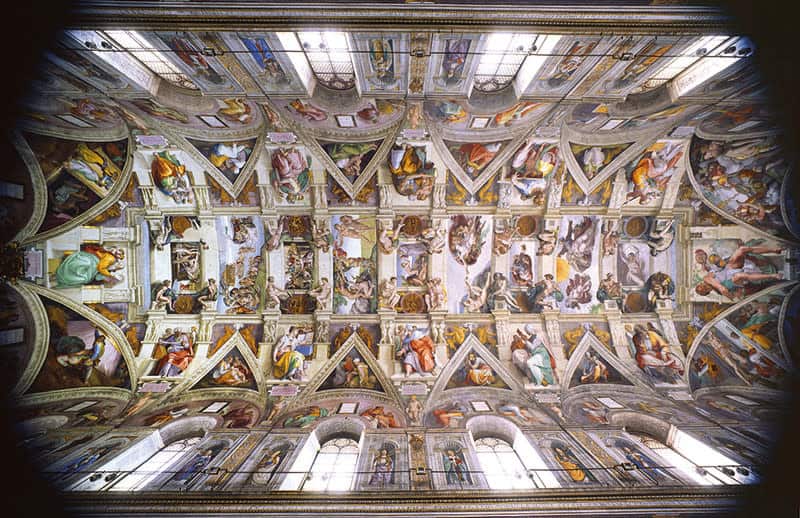
Julius II died a few months later, in February 1513, and his heirs renewed the design of his tomb, but at a lower cost and with fewer statues. Even so, the tomb was never completed to Michelangelo's satisfaction. After the death of Julius II, Giovanni de' Medici (Leo X), who knew Michelangelo and his talents well, was elected the new pope and hired him to serve from 1513 to 1534. He demanded so much work from him that Michelangelo had no time for a tombstone. In the end, he managed to make only six sculptures, of which the figure of Moses, made between 1514 and 1516, deserves admiration. The tomb is located in the Basilica of San Pietro in Vincoli, Rome.
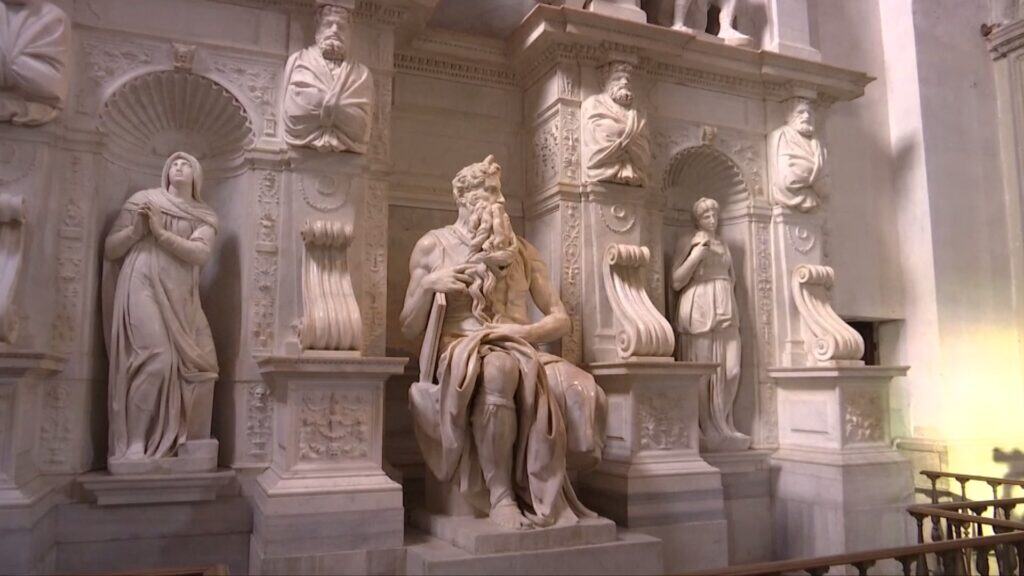
Pope Leo X died in December 1521. In the 1520s, Michelangelo worked in Florence on the construction and sculptural decoration of the Medici Chapel in the Church of St Lawrence with the tombstones of members of the family. His work was interrupted after the expulsion of the Medici from the city during the revolutionary events of 1529-1530, when he was appointed Commissary General of the Florentine fortifications for the protection of the city. After the return of Alexander de' Medici, he completed the allegorical sculptures Sunset and Sunrise, Night and Daysitting Madonna and Child Jesus and statues of saints Kosmy a Damiana.
In 1534 Pope Clement VII summoned him to Rome to complete the paintings in the Sistine Chapel and appointed him supreme architect, painter and sculptor of the papal palace. He then left Florence permanently.
Twenty-one years after the completion of the ceiling frescoes, he was also to decorate the entire altar wall of the Sistine Chapel with frescoes and repaint Perugino's existing frescoes. Michelangelo hesitated for a long time, however, and did not begin work on the work until two years later, at the insistence of Clement's successor Paul III, whose more relaxed views allowed him to let his imagination run wild. He worked alone, without helpers, for seven years from 1536 to 1543, producing the largest single fresco of the century at that time.
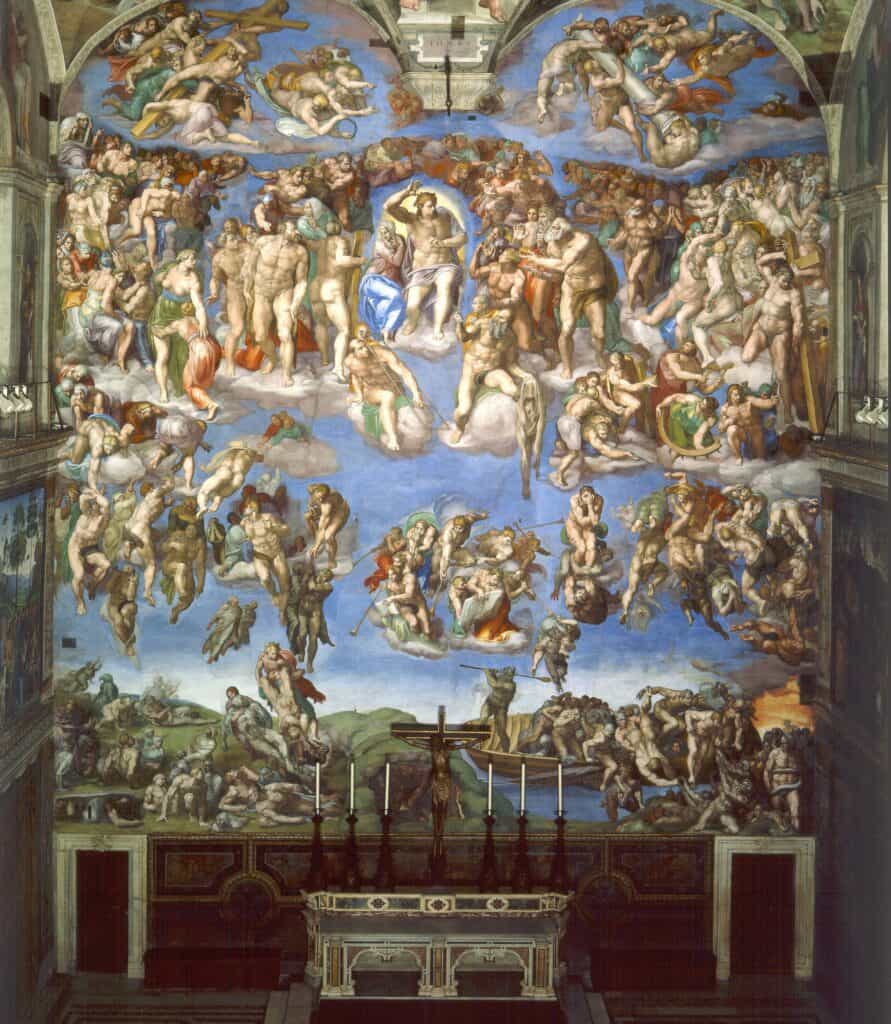
The monumental fresco covers an area of almost 165 square metres and features 390 figures. It depicts the events foretold in the prophetic books of the Bible, especially the Revelation of St. John. The Pope is said to have chosen this theme as a warning to the faithful to remain in the faith during the Reformation. It is also possible that the choice of theme The Last Judgment contributed to the dramatic historical event known as the Sacco di Roma (sack of Rome) in May 1527, which was seen as a harbinger of God's judgment. As is usual with Michelangelo, most of the figures were originally completely nude, but after his death in 1565, by order of Pope Pius IV, all the nude figures were painted with drapery.
Even before the fresco was finished, Cardinal Biagio da Cesena, offended by its nakedness, declared that it was at most suitable for the wall of a hangout. Offended, Michelangelo promptly painted the cardinal as the naked ruler of hell with donkey ears and a snake biting his genitals. But the Pope was a fan of the painter and when the Cardinal complained to him, he refused to have the figure repainted. He declared that paintings depicting hell were outside his jurisdiction.
In the last period of his life Michelangelo devoted himself mainly to architecture. From 1546 he was commissioned to complete St Peter's Basilica, specifically the western part of the temple and the dome, and to redesign the Piazza del Campidoglio into the Capitol, and he also undertook the completion of the Farnese Palace. At that time he was already over seventy years old. Many of his predecessors had worked on St. Peter's Basilica, and Michelangelo adopted Bramante's original plan, which he simplified for his purposes, but only lived to see the completion of the main dome with its row of double columns. His last sculptural work is Pieta Rondanini, which was painted between 1552 and 1564 and was never finished, is on display at Sforzesco Castle in Milan.
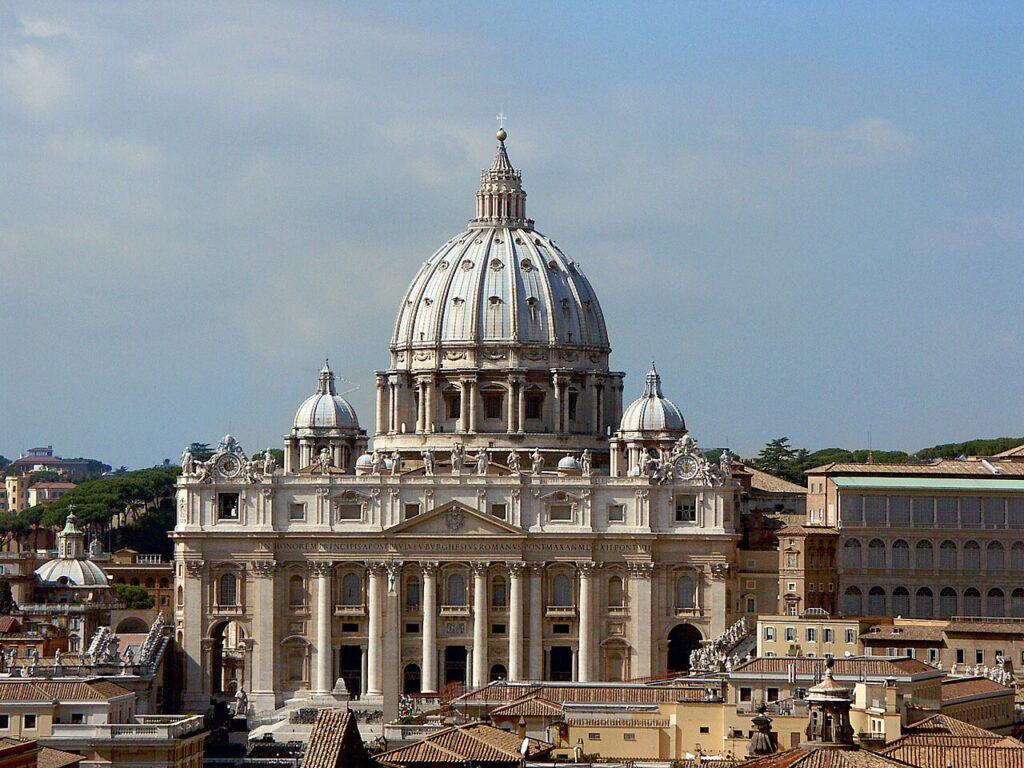
In 2007, a previously unknown sketch of St Peter's Basilica, drawn by Michelangelo in red chalk, was found in the Vatican archives. It is a rarity not only because of the length of time it has been in the archives, but mainly because Michelangelo destroyed all his architectural designs at the end of his life.
Michelangelo is said to have been left-handed, but he hid it from the public because of prejudice, because the Church considered left-handedness to be a sign of the devil. He therefore learned to write and paint with his right hand, but used his left hand to carve stone, as he had more strength and skill in it. Incidentally, Leonardo da Vinci was also left-handed.
Given the scale and number of his commissions - he worked for nine popes and the most important church dignitaries, for the Medici and the Florentine Republic - Michelangelo became a very wealthy man. In fame and wealth he surpassed his contemporaries, with whom he rivalled Leonardo da Vinci, Raffaele, Titian...
Throughout his life he cared for the welfare of his family, caring for his father and four brothers and their families. He never married and had no children. He said marriage was for men who needed comfort, but he needed only marble and solitude, and his children were his statues. According to the disciple Ascanius Condivi, he was very frugal, eating more out of necessity than pleasure, and only bread and wine sufficed. He worked much and slept little, often in clothes and shoes so as not to have to drown, and he rarely changed his clothes. His hygienic habits were minimal, he was a harsh and volatile perfectionist, solitary by nature, shunned people and said of himself: "No matter how rich I was, I always lived like a poor person. I was not made for comfort. I was made for stone and struggle." There are now suggestions that he was autistic.
It was only in his old age, at the age of sixty, when he left Florence, that he became independent from his family and established a relationship with the young Roman patrician Tommaso Cavalieri, whom he first met in 1532, at the age of fifty-seven.
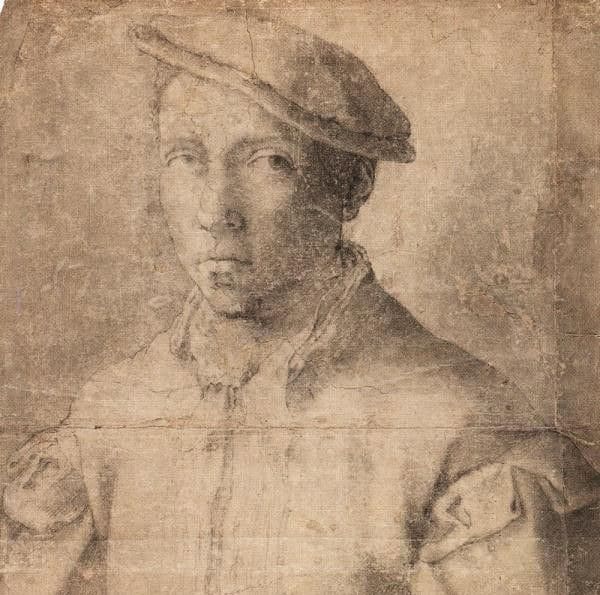
They shared a close friendship and a love of art, and Tommas became his muse and inspiration, but despite numerous theories about Michelangelo's homosexuality, it is unlikely that such a public relationship between them was a sexual affair. Moreover, Cavalieri was married and had two sons (his wife Lavinia died in November 1553).
During the work on the fresco The Last Judgment Michelangelo also became close to the poetess and noble widow Vittoria Colonna, Marquise of Pescara, who was just over forty at the time.
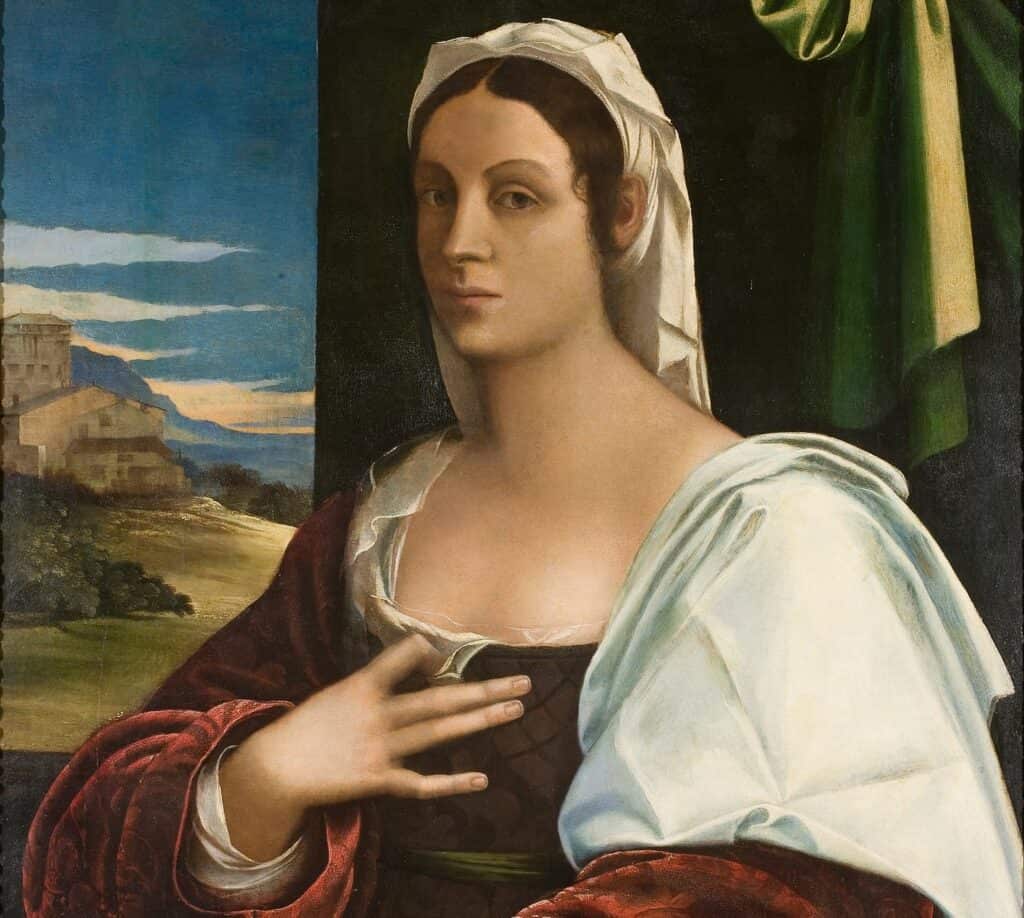
They wrote letters to each other about spiritual matters, exchanged sonnets and drawings, and Michelangelo claimed that she was the only one who understood his soul. They were in regular contact until her death in February 1547. Michelangelo was at her deathbed and later wrote: "Death stole my great friend, the only mirror I could see myself in."
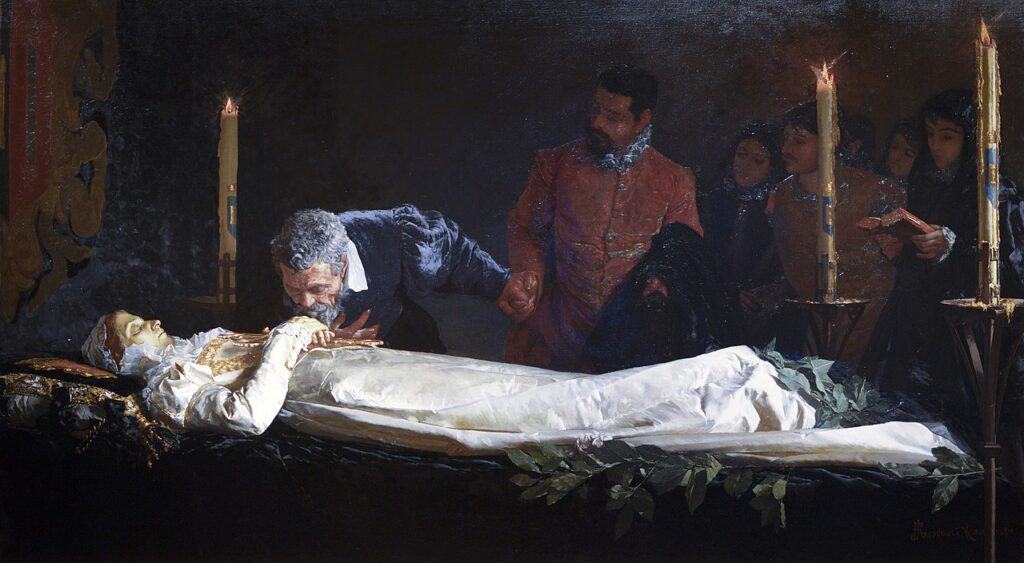
In fact, it is not known, and there are no documents to prove, whether Michelangelo had any intimate relations with women or men. The famous sculptor embraced the ideals of Plato, who believed that love between two men was the ultimate spiritual experience, not necessarily a physical one. Thus, the assessment of Michelangelo's sexuality rests mainly on the fact that he did not marry, employed young apprentices, painted naked male bodies and women with male features, and also on his poetry. He wrote more than three hundred sonnets and madrigals in the margins of his sketches, letters and notes. They were written mainly in the second half of his life under the pressure of real life experiences and circumstances, and they also reflect his emotional life. Some sixty of them are addressed to men - especially Cavalieri, who remained devoted to Michelangelo until his death. The sonnets were published sixty years after the artist's death by his great-nephew Michelangelo the Younger. They were published in Czech in 1929 in a translation by Jaroslav Vrchlický.
It is certain that in his old age Michelangelo gave himself over to an intense and strict religiosity. Until his death he lived in his modest little house in Rome, only in 1557 he was forced to leave for a time because of the threatened invasion of Spanish troops. He died of natural causes on 18 February 1564, aged 89, surrounded by his unfinished works and a few favourite objects, of which he treasured most the Bible and a yellowed letter from Vittorio Colonna. Historical records indicate that he had suffered from fever and probably kidney stones in his last days. His last wish was to be buried in his beloved Florence, but Pope Pius IV decided that his remains should remain in Rome. Michelangelo's nephew Lionardo Buonarroti decided to fulfil Michelangelo's wish regardless of the consequences, smuggling the body out of the city in a bundle of merchant's cloth and secretly transporting it to Florence on a cart as merchandise. The brilliant artist was buried in the Basilica of the Holy Cross in Florence.
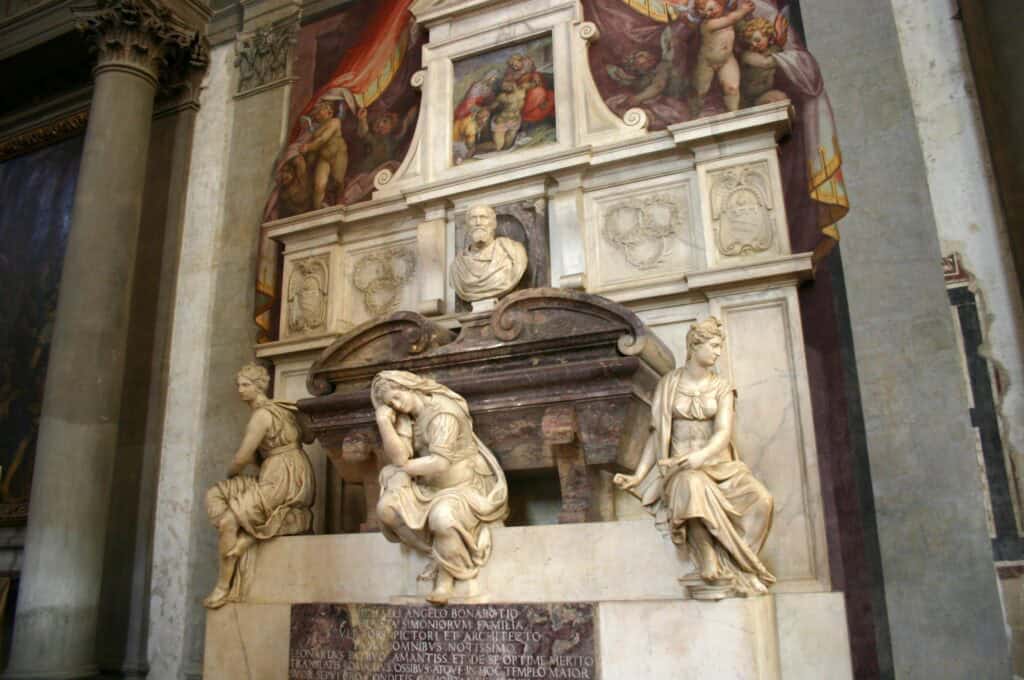
His death marked the end of an era in the history of Renaissance art.
Wikipedia/ gnews.cz - Jana Černá


